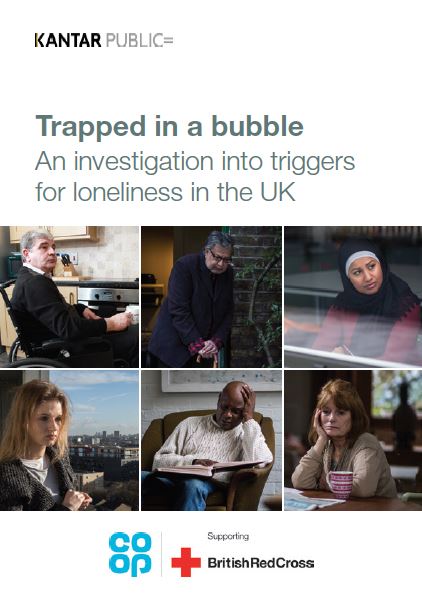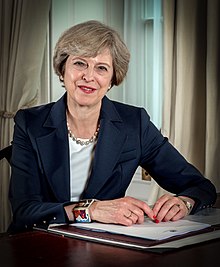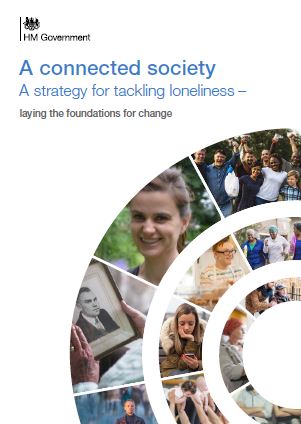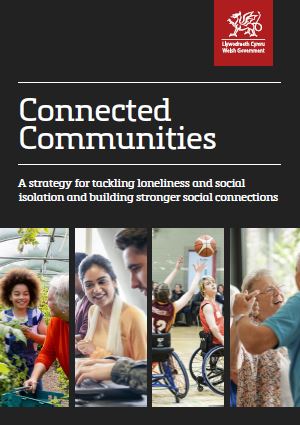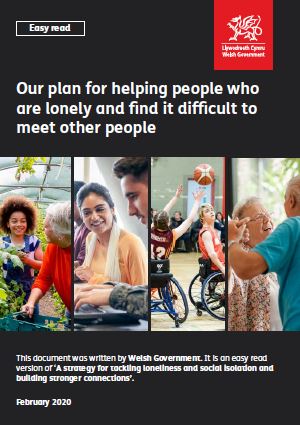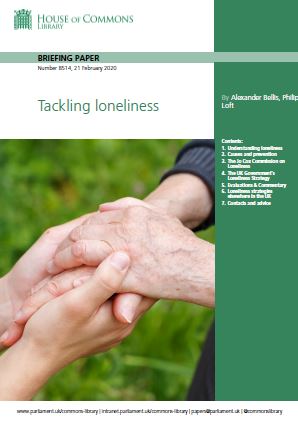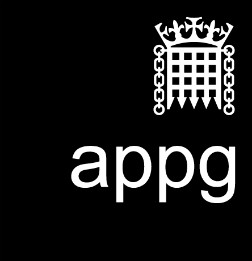- Many of the commitments made in the Loneliness Strategy have been delivered and the remainder are on track (see Appendix B for pledge-by-pledge tracker).
- Loneliness has enjoyed strong engagement from ministers and spurred genuine collaborative working between departments.
- Particularly good areas of progress have been social prescribing, national loneliness measures, and funding to help maximise the potential of underutilised community spaces.
- However, much of the (uneven) progress has been to lay the foundations for future action, but this has not yet achieved widespread change.
- With solid foundations, Government now needs to take efforts to the next level.
Tackling loneliness in the UK
The United Kingdom has been at the forefront of a nationwide approach to tackling loneliness. We provide a case study of their approach, broken into five phases:
Phase 1. Champions for loneliness
Phase 2. Evidence-base for action
Phase 3. Jo Cox Commission on Loneliness

Phase 1. Champions for loneliness
Making change happen typically requires one or more champions. Whilst many people have been involved, the original champions of loneliness in the UK were the Co-operative Group (and its members), the British Red Cross, and Member of Parliament Jo Cox.
The campaign to address loneliness in the UK was initiated by the community. As part of its ethical brand, the Co-operative Group – trading as Co-op – campaigns on social and consumer issues of interest to its 4.6 million members. In 2015 the Co-op asked its members for the big issues facing their communities. Members overwhelmingly voted in favour of tackling loneliness in partnership with the British Red Cross.
The British Red Cross encountered loneliness and social isolation frequently in its work. In partnership with the Co-op, the British Red Cross wanted to take action to address the loneliness and social isolation crisis. The British Red Cross – supported by the Co-op – commissioned the research that provided the evidence base for action.
Jo Cox became a Labour Party MP in May 2015. Given her experiences with loneliness at university and the prevalence of loneliness in her constituency, she campaigned to increase the profile of the hidden crisis of loneliness, and set-up (with her colleague Conservative MP Seema Kennedy) the Commission on Loneliness. She wanted the Commission to bring new focus and attention to loneliness in our communities, and to encourage action. After her murder in June 2016, the Commission on Loneliness became the Jo Cox Commission on Loneliness.
The Co-op and British Red Cross provide the secretariat for the All-Party Parliamentary Group (APPG) on Loneliness – which aims to influence legislation and policy making to reduce loneliness across the UK. The Co-op and British Red Cross also lead the Loneliness Action Group, which was tasked by the Jo Cox Commission on Loneliness to partner with government, charities, businesses and public sector leaders to make sure the Commission’s call to action to tackle loneliness is heard.
Phase 2. Evidence base for action
To provide the evidence base for action, the British Red Cross reviewed existing research over the past 40 years and commissioned Kantar Public to address the significant gaps in the evidence base. In December 2016, the Co-op and British Red Cross partnership produced the comprehensive loneliness report Trapped in a bubble.
The research sought to understand:
- What the general public thinks about loneliness.
- The causes, experiences, and impacts of six selected groups at risk of loneliness.
- How loneliness transitions from a temporary situation to a chronic issue, and how to prevent this.
- The support available for people experiencing loneliness in the UK.
- What kind of support is needed to tackle loneliness, and what potential services
users want.
- Public viewed loneliness as an important issue.
- Loneliness is a common experience.
- There is a incorrect perception that loneliness is solely or predominantly associated with seniors.
- People experiencing life events that may disrupt existing connections are at risk of loneliness.
- People experiencing loneliness can view connection as a daunting experience.
- Loneliness can have serious consequences for individuals (e.g., physical, psychological and social impacts).
- Those who find engaging in social relationships difficult are at greater risk of experiencing loneliness.
- People is physical isolation or with mental health issues are at greater risk of transitioning to chronic loneliness.
- The causes of loneliness are often complex, multi-layered and reinforcing.
- Loneliness is caused by a combination of personal, community and broader society issues.
- There was low awareness of support for loneliness, which was fragmented and not fit for purpose.
- Current loneliness support prioritised seniors.
- Short-term/one-off interventions are problematic.
- People experiencing loneliness prefer face-to-face services and support.
- People experiencing loneliness need different types of support depending on their individual circumstances.
- To prevent and tackle loneliness, different stages of need require a combination of formats and programmes.
- Sometimes it was ‘small gestures’ which can make the most difference for people experiencing loneliness.
- Prevention of loneliness can target life events.
- Preventing and tackling loneliness requires a society-wide response where the strengths of multiple partners are utilised.

The Co-op and British Red Cross published a follow-up report: Barriers to belonging: an exploration of loneliness among people from Black, Asian, and Minority Ethnic backgrounds.
Phase 3. Jo Cox Commission on Loneliness
The Jo Cox Commission on Loneliness was a cross-party commission led by thirteen charities and businesses. The role of the Commission, as Jo Cox envisaged, was to ‘turbo charge’ the response to loneliness. The Commission prompted moving debates in Parliament and commitments on loneliness and social isolation in the manifestos of the two main parties at the 2017 General Election. After a year’s work, the Commission published its report in December 2017. The report, Combatting loneliness one conversation at a time, challenged national government to step forward and lead a renewed push to tackle loneliness.
National leadership
- A national strategy for loneliness across all ages, led by Government with the input of expertise from all stakeholders. The national strategy underpinned by equivalent local strategies. Central Government reporting annually to parliament on progress reducing loneliness.
- A nominated Lead Minister to drive action on loneliness across Government, with lead responsibility for the development and implementation of the loneliness strategy.
- The current Family Test to become a Family and Relationship Test through which new Government policy is assessed not only for its impact on families, but also on connections between individuals and within communities.
Measuring progress
- A national indicator on loneliness across all ages included in national indicator sets to enable effective monitoring of progress at national and local level.
- Measures of loneliness included in major national studies to deliver high quality data which can illuminate the wider causes and impacts of loneliness.
- Annual reporting on loneliness, looking across a range of data, by the Office for National Statistics.
- Investment in a programme to develop the evidence around ‘what works’ in tackling loneliness across all ages and within all communities.
- Easy-to-understand messages to help individuals connect with others and avoid loneliness, developed by Public Health England.
Catalysing action
Government to work together with trusts, foundations and other funders to create an innovation and spread fund, which can:
- stimulate innovation in solutions to loneliness across all ages, backgrounds and communities;
- provide seed funding for communities in need to come together to develop self-sustaining community activities which enable people to connect; and
- scale-up and spread promising approaches to reaching out to isolated lonely individuals, offering practical and emotional support to overcome the barriers to reconnection – including community navigators and connectors, social prescribing schemes etc.
The Commission believed that not only must Government act: but also metro mayors and council leaders, public sector leaders, business leaders and employers, community and voluntary groups, and each and every one of us.
Phase 4. UK Loneliness Strategy
In January 2018, the UK Prime Minister Theresa May accepted many of the recommendations of the Jo Cox Commission on Loneliness. She commissioned the UK Loneliness Strategy, appointed a Ministerial Lead for loneliness (referred to as the “Minister for Loneliness”), committed to work to develop indicators on loneliness that could be used in research studies with people of all ages, and incorporated loneliness into the Families Test. Furthermore, in June 2018, the Prime Minister announced £20 million of funding to support voluntary, community and charitable organisations to tackle loneliness, building on the fantastic work they are already doing.
The commissioned UK Loneliness Strategy has been developed so far for England, Wales, and Scotland.
Loneliness Strategy for England
In October 2018 the world’s first government Loneliness Strategy was published, with a foreword by the Prime Minister: A connected society. A strategy for tackling loneliness – laying the foundations for change. The strategy focuses on preventing people from feeling lonely all or most of the time.
The vision is for England to be a place where everyone can have strong social relationships. Where families, friends and communities support each other, especially at vulnerable points where people are at greater risk of loneliness. Where institutions value the human element in their interactions with people. And where loneliness is recognised and acted on without stigma or shame, so that we all look out for one another.
The Strategy contains about 60 commitments, across nine government departments, to lay the foundations for long-term work on loneliness. The strategy sets out existing and new government commitments and partnerships in three areas.
1. Organisations that support and enable people’s relationships
The Government, working with local authorities, business and civil society, will:
- improve how organisations and services connect people at risk of experiencing loneliness to support, by ensuring all GP practices can offer social prescribing services and exploring how other frontline staff can also direct people to support.
- make it easier to access information about local community groups, activities and support services for loneliness.
- catalyse the sharing of knowledge and good practice on tackling loneliness.
2. Community infrastructure that powers social connection
The government will work with local authorities, the voluntary sector, transport providers, and digital and social media companies to:
- unlock the potential of underutilised community space.
- create a transport network that supports people’s social connections and helps people be connected to their community.
- place community at the heart of the design of housing developments and planning.
- maximise the power of digital tools to connect people.
3. Building a culture that supports connected communities
The government will work with others to:
- Build a national conversation to raise awareness and reduce the stigma surrounding loneliness.
- Support grassroot opportunities to strengthen local social relationships and community ties.
The reader is referred to the strategy document for the details behind these commitments.
Loneliness Strategy for Scotland
In December 2018 the Loneliness Strategy for Scotland was published, with a foreword by the Minister of Older People and Equalities: A connected Scotland: Our strategy for tackling social isolation and loneliness and building stronger social connections.
The vision is for Scotland to be where individuals and communities are more connected and everyone has the opportunity to develop meaningful relationships regardless of age, status, circumstances or identity.
The strategy has four priorities.
1. Empower communities and build shared ownership
- Community cohesion and empowerment.
- Invest resources in communities.
- Every age, stage, and walk of life.
- Encouraging everyone to play their part.
2. Promote positive attitudes and tackle stigma
- Build positive and healthy relationships.
- Reduce stigma.
- Encourage kindness.
- Improve mental wellbeing.
- Promote intergenerational dialogue.
3. Create opportunities for people to connect
- Raise awareness of opportunities.
- Promote befriending.
- Promote physical activity.
- Promote and enable volunteering.
- Utilise technology and digital.
4. Support an infrastructure that fosters connections
- Person centred health and social care.
- Build safer communities.
- A growing third sector and social economy.
- Placemaking.
- Digital infrastructure.
- Culture and historic environment.
The reader is referred to the strategy document for the details behind these priorities.
Loneliness Strategy for Wales
In February 2020 the Loneliness Strategy for Wales was published, with a foreword by the Deputy Minister of Health and Social Services: Connected communities: A strategy for tackling loneliness and social isolation and building stronger social connections. The strategy focuses on approaches that reduce the risk of, or prevent, loneliness and social isolation or that intervene early, before these become more entrenched.
The vision is for Wales to be where everybody has the opportunity to develop meaningful social relationships and where people are supported at those times in their lives when they are most vulnerable to loneliness and social isolation, by friends, family, communities and institutions and organisations within wider society. A Wales where people feel able to say “I’m lonely” without stigma or shame.
The strategy has four priorities.
1. Increasing and promoting opportunities for people to connect
- Promoting sport and physical activity.
- Promoting and enabling volunteering.
- Enabling social connections through culture, heritage, and arts.
- Supporting and enabling digital inclusion.
- Raising awareness of opportunities to connect.
- Supporting and enabling people to connect through social prescribing services.
- Supporting those at greatest risk.
2. A community infrastructure that supports connected communities
- Creating a transport system that supports social connections.
- Making the most of digital technology to connect people.
- Enabling communities to come together through good quality planning and housing.
- Making better use of community spaces.
3. Cohesive and supportive communities
- Developing more cohesive communities.
- An integrated health and social care system that support wellbeing and community engagement.
- Tackling poverty.
4. Building awareness and promoting positive attitudes
- Building a national conversation to promote mental wellbeing and raise awareness.
- Supporting children and young people to establish and maintain meaningful social connections.
- Supporting good mental health, wellbeing and resilience among the wider population.
The reader is referred to the strategy document for the details behind these priorities.
Phase 5. Implementation of Strategy
There has been forethought to ensure loneliness does not become forgotten after the strategy is completed. Since September 2019, there has been the shadow report on progress tackling loneliness, the first Loneliness Annual Report, tackling loneliness briefing paper, and AAPG Loneliness Inquiry.
Shadow report on progress tackling loneliness
In September 2019 the Loneliness Action Group published a shadow report on progress tackling loneliness in the UK: A connected society? Assessing progress in tackling loneliness. The report assessed progress of the Loneliness Strategy for England published the year prior in October 2018. The report found that good positive progress had been made although it warned, with the change of political leadership: “We are now at a critical point in our journey to tackle loneliness. With a solid foundation in place, government needs to reaffirm its commitment to the issue if widespread, tangible change is to be felt in people’s lives. We must not lose the momentum built up in recent years.”
- Sustain and fund action across government.
- Measure impact.
- Move from development to delivery.
- Invest in the infrastructures communities need to stay connected.
- Ensure social prescribing delivers for loneliness.
- Build capacity to address loneliness among children and young people.
The reader is referred to the shadow report for the specifics behind these recommendations.
First Loneliness Annual Report
In January 2020 the first Loneliness Annual Report was published by HM Government, with a foreword by the Secretary of State for Digital, Culture, Media, and Sport and Minister for Civil Society.
The Annual Report summarises the successes to date, and lists its 60 loneliness strategy commitments in the annex. The report outlines three areas of focus for this year:
- The need for more information and communication about loneliness and the activities which are available to reduce it.
- The need for further policies targeted at tackling children and young people’s loneliness.
- The need to tackle loneliness through place – strengthening community infrastructure and assets, and growing people’s sense of belonging.
The Government expects to make announcements in these areas later in the year.
Tackling loneliness briefing paper
In February 2020 a loneliness briefing paper Tackling loneliness was published by the House of Commons Library that summarised the state of loneliness in the UK and progress to tackle it. The paper covers:
- Understanding loneliness.
- Causes and prevention.
- The Jo Cox Commission on Loneliness.
- The UK Government’s Loneliness Stategy.
- Evaluations and commentary.
- Loneliness strategies elsewhere in the UK.
- Contacts and advice.
The briefing paper has useful hyperlinks to a range of source materials.
APPG Loneliness Inquiry
The All-Party Parliamentary Group (APPG) on Loneliness has launched a Loneliness Inquiry. The inquiry will seek to:
- Hold government to account and secure a renewed cross-Government commitment to tackling loneliness and its underlying causes.
- Build on progress made to date, by recommending tangible and ambitious next steps for government, at the end of the inquiry in December 2020.
- Explore solutions to crucial but complex policy areas identified by the Loneliness Action Group as outlined within the Shadow report, A connected Society? Assessing progress in tackling loneliness.
Consultation closed on 30 April 2020. The Loneliness Inquiry held three oral evidence sessions in July and August 2020.
Session 1: The role of Local Authorities in tackling loneliness
Session 2: What changes need to be made to Community Infrastructure
Session 3: Funding the Voluntary and Community Sector





